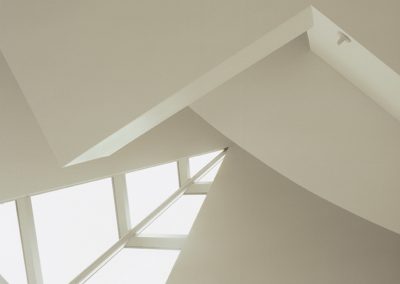Chelsea, QC
Description
Designed for the architect himself the Glass House is Keenberg’s ode to Mies and Philip Johnson.
Four shaped columns, two articulated trusses and a rolled 7½” deck, glazing from the industrial shelf, battleship linoleum and a touch of stainless steel – acorn nuts, no marble, no brick.
On a cliff in the forest, overlooking the lake like Gatineau River.
A garden modulating the landscape offers elegant ‘meadow’ openings on the way to Keenberg’s suspended gazebo.
The glass house’s transparency allows it to appear and disappear as it reflects the forest, the dappled sun, the hard blue sky or its various clouded forms.
The pavilion, in stark contrast, is pure geometry, an icon of a past time, a temple in the forest after all, it’s Mrs. Keenberg’s private place.
Structure
Four tapered 15ft high steel plate columns. 2 articulated steel trusses spanning 65ft supporting a 7½” deep rolled corrugated deck with galvalume finish. The steel is blasted and clear coated.
Skin
Off the shelf curtain wall. The pavilion has a corrugated mill finish aluminum rain screen.
Mechanical
Three residential gas fired hot air furnaces with summer air conditioning integrated units.
Electrical
The lighting has fifteen ‘scenes’, no switches, all remote – no plugs – when you need power it is brought up from the lower walking crawl space.
Fitments
A stainless steel ‘studded’ box, low assembled walls with flush doors, and a kitchen all in one element.
The Pavillion – Soring sloping drywall, an arched desk and a bought spiral stair.
Action Strategies
A transparent shelter in the forest – protected while part of nature – a blind form where one watches nature pass by.
Key Information
Completed
1998
Project Cost
Witheld
Building Area
300m² / 3,200 ft²
Publications
Canadian Architect, June 2003
Glass House
Chelsea, QC
Description
Designed for the architect himself the Glass House is Keenberg’s ode to Mies and Philip Johnson.
Four shaped columns, two articulated trusses and a rolled 7½” deck, glazing from the industrial shelf, battleship linoleum and a touch of stainless steel – acorn nuts, no marble, no brick.
On a cliff in the forest, overlooking the lake like Gatineau River.
A garden modulating the landscape offers elegant ‘meadow’ openings on the way to Keenberg’s suspended gazebo.
The glass house’s transparency allows it to appear and disappear as it reflects the forest, the dappled sun, the hard blue sky or its various clouded forms.
The pavilion, in stark contrast, is pure geometry, an icon of a past time, a temple in the forest after all, it’s Mrs. Keenberg’s private place.
Structure
Four tapered 15ft high steel plate columns. 2 articulated steel trusses spanning 65ft supporting a 7½” deep rolled corrugated deck with galvalume finish. The steel is blasted and clear coated.
Skin
Off the shelf curtain wall. The pavilion has a corrugated mill finish aluminum rain screen.
Mechanical
Three residential gas fired hot air furnaces with summer air conditioning integrated units.
Electrical
The lighting has fifteen ‘scenes’, no switches, all remote – no plugs – when you need power it is brought up from the lower walking crawl space.
Fitments
A stainless steel ‘studded’ box, low assembled walls with flush doors, and a kitchen all in one element.
The Pavillion – Soring sloping drywall, an arched desk and a bought spiral stair.
Action Strategies
A transparent shelter in the forest – protected while part of nature – a blind form where one watches nature pass by.
Key Information
Completed
1998
Project Cost
Witheld
Building Area
300m² / 3,200 ft²
Publications
Canadian Architect, June 2003









